The capital of a tiny landlocked country, Vientiane in Laos whispers stories of a rich and serene past. Travelers and adventurers alike flock to this city, drawn by its blend of ancient charm and emerging modernity.
While some consider Vientiane a gateway to spiritual wonders like Wat Si Muang and Vat That Khao, there are much more things to do in Vientiane than exploring its honored landmarks. It weaves together remnants of the ancient Lao kingdom with French-colonial architecture and vibrant local markets, forming a tapestry that celebrates both history and contemporary life.
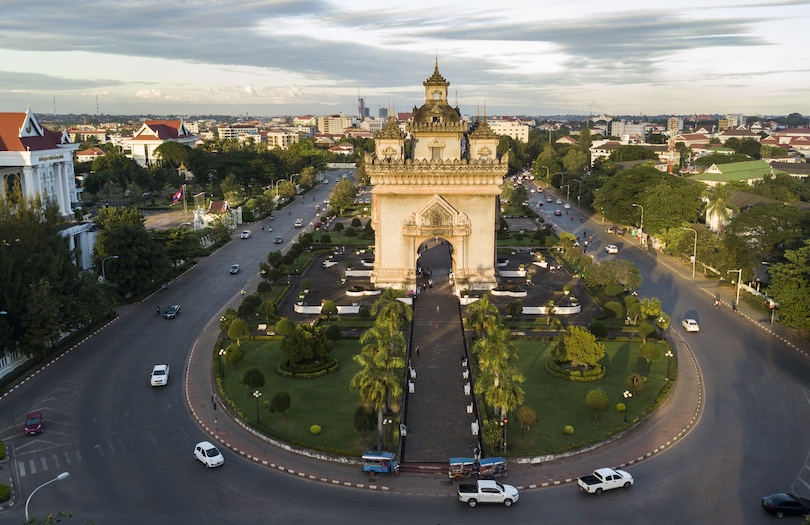
Exploring the streets of downtown Vientiane, scents of tradition and diverse cuisines mingle, guiding visitors through an aromatic journey. As the sun sets and the gold glimmering off of Phat That Luang settles for the night, the city transforms into a hub of activity, drawing in global wanderers to its enchanting night markets and relaxing riverfront.
Amidst the enticing offerings, tales of the day’s escapades are exchanged, creating an atmosphere that encapsulates the essence of Vientiane’s allure—a city that harmonizes ancient tales with modern-day adventures.
In this post, we'll cover:
12. Vat that Khao
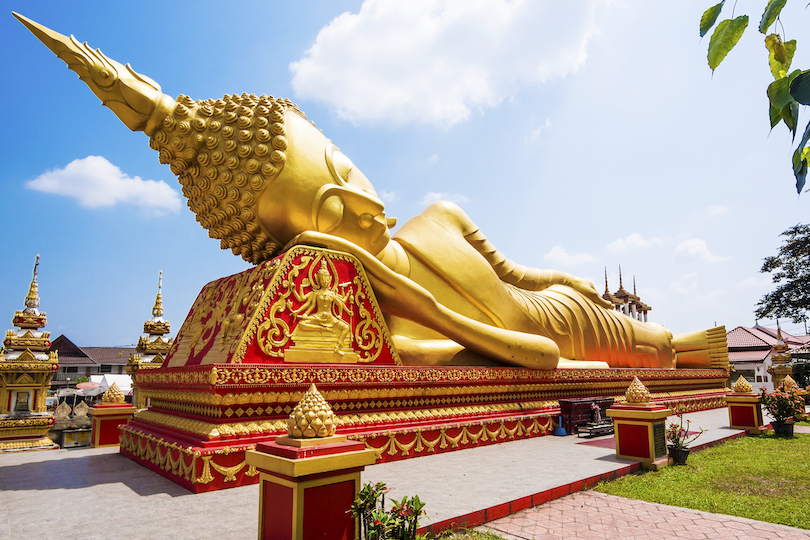
Embodying classic Lao-style architecture, Vat That Khao boasts three remarkable focal points that will leave you in awe. First, the main temple entrance is surrounded by standing Buddha statues, while the roof’s front gable displays intricate golden stencil work. Inside, vibrant murals portraying scenes from the life of Buddha adorn the temple’s interior, adding vivid colors and narrative to the sacred space.
The second highlight is the expansive gardens surrounding the temple, housing some of the largest golden statues in Laos. Notably, the grand golden reclining Buddha stands out among these serene surroundings, offering a peaceful moment of serenity.
The third focal point is the revered bodhi tree situated within the temple grounds. Believed to be a descendant of the original bodhi tree where Lord Buddha attained enlightenment in Bodh Gaya, India.
11. Wat Si Muang
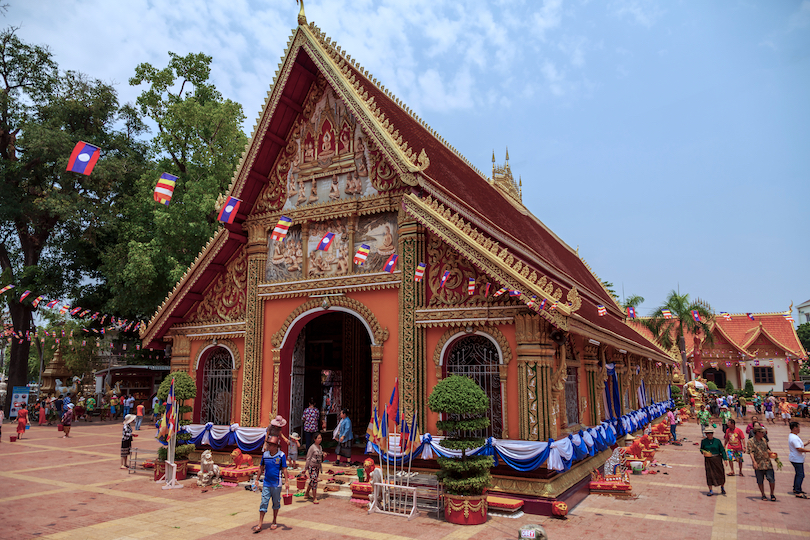
Steeped in cultural vibrancy and spiritual significance, Wat Si Muang is a revered site, believed to shelter the guardian spirit of Vientiane. Various legends recount the temple’s history, but they all converge on a common narrative involving a young pregnant woman sacrificing herself during the temple’s construction around 1566 to appease a vengeful spirit.
The original temple was ravaged by a fire in 1828, with the current structure erected in 1915 during the French colonial period. A Buddha statue, believed to have survived from the original structure, has been attributed to wish-granting abilities.
Visitors practice a ritual where they lift the Buddha off its pillow three times while silently asking a question or request. Should their wish be fulfilled, tradition dictates returning later with an offering as a sign of gratitude.
10. Night Market
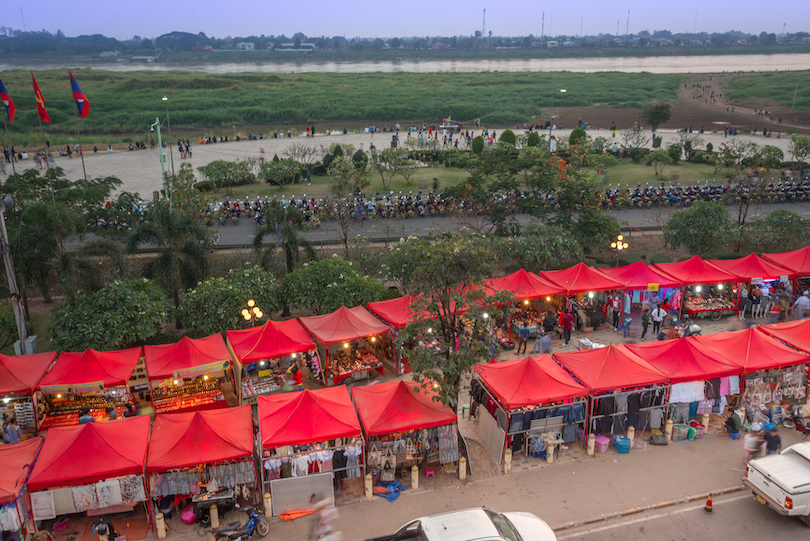
Sitting along the Mekong River promenade, the Vientiane Night Market casts a mesmerizing glow with its twinkling lights and lively ambiance. Open every night from 6 pm until 10 pm, it’s easy to get lost within the atmosphere of the bustling market.
Here, the stalls brim with an array of goods, including clothing, jewelry, paintings, and an assortment of treasures. Each vendor has their own distinct collection, so you are promised a unique find.
The night market is a haven for food enthusiasts. Indulge in a diverse selection of mouthwatering Lao treats like papaya salad, sticky rice, and savory grilled meats. Don’t miss the opportunity to relish the traditional Khao Piak (rice noodle soup). With pocket-friendly prices, the market ensures a memorable experience without breaking the bank.
9. Go on a cycling trip

Exploring Vientiane is an incredibly rewarding experience on foot. But sometimes you want to get a little wind in your hair and a little speed under your feet. Jump on two wheels and get exploring.
Not only will you be able to see the best of downtown Vientiane quicker on two wheels, travelers will have easy access to wider countryside. The busy streets of downtown quickly fall away and you’ll soon find yourself in peace as the Mekong rolls into the foothills and buildings are replaced by fields and trees.
But if you’re up for a proper trip, why not take your bicycle journey to another level? The bike touring route between Vientiane and Luang Prabang has become popular over the last few years. The week-long 430km journey encompasses much of Laos’ dramatic scenery.
8. Haw Phra Kaew
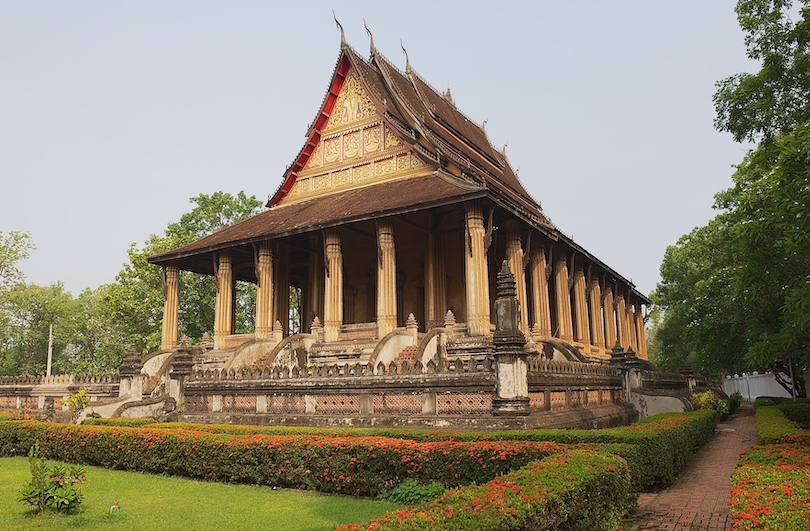
Haw Phra Kaew is considered one of the most beautiful and impressive temples in Vientiane. Built in 1565 as the chapel for the royal family, Haw Phra Kaew was home for a while to the Emerald Buddha that was stolen from Thailand.
The name of this gracious building translates to the Temple of the Emerald Buddha, though the Thais stole the statue back in the 18th century. It is now a museum, no longer used for religious services. T
he temple is famous for its wood and stone carvings, and collection of Buddhas. With a dragon guarding the temple, visitors can sit in peace in the garden to rest or meditate.
7. Lao National Museum
The Lao National Museum is a good place to learn about the Lao people from prehistoric times on as well as spend a few hours out of the sun. It’s located in an old French colonial building that is falling apart and some of the exhibits are faded, but this doesn’t detract from the contents.
The bottom floor concentrates on the country’s early history, with dinosaur bones and pottery shards. The upper floor deals with a more modern Laos, including French colonization and fight for independence, and United States’ presence during the Vietnam War.
6. COPE Visitor Centre
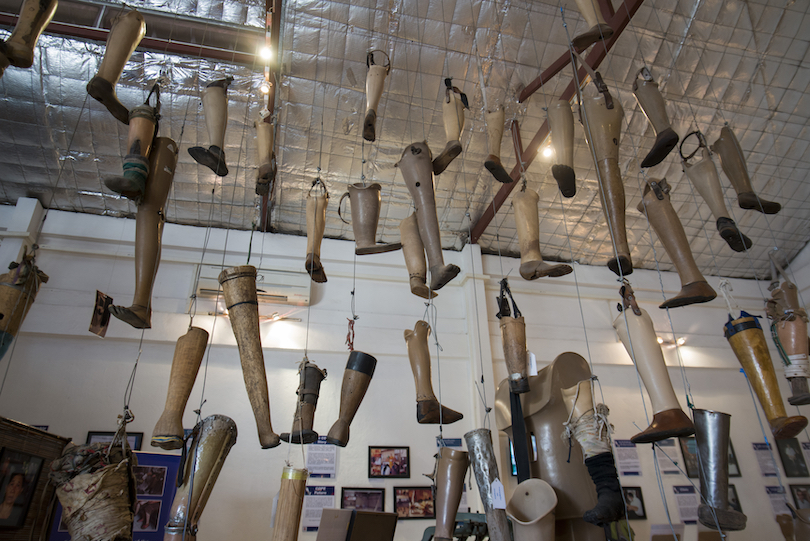
Laos is the most heavily bombed country in history, with about 30 percent of the ordinance failing to explode properly. Even though Laos is at peace now, these devices are still going off, killing and maiming people.
COPE, short for Cooperative Orthotics and Prosthetics Enterprise, works to rehabilitate people whose lives have been destroyed by these devices, which include bombs and grenades.
Visitors to the center can learn more about the problem of unexploded devices in Laos as well as the treatment provided to victims. An excellent gift shop offers fun, offbeat souvenirs that support a good cause.
5. Wat Si Saket
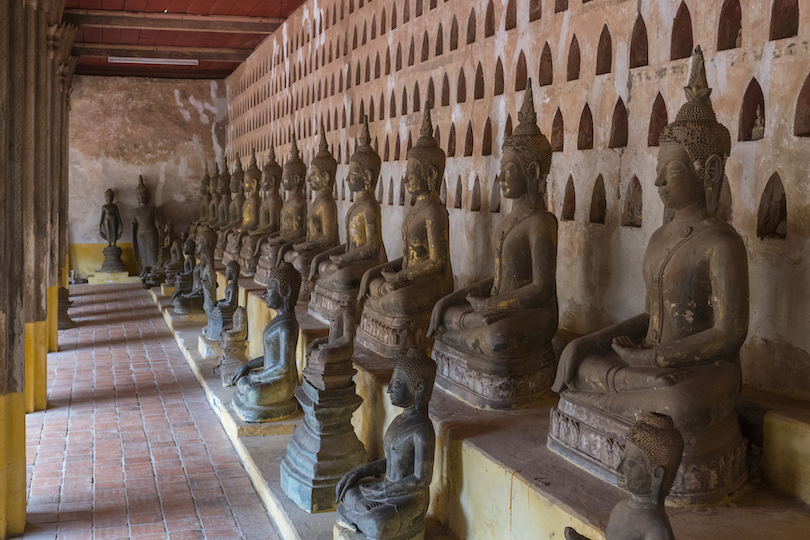
Wat Si Saket is a Vientiane temple that is famous for a wall that contains hundreds of seated Buddhists sitting before thousands of tiny images in soft triangular shaped openings in the wall. The 6,800 images are made from wood, stone and bronze.
This amazing collection of Buddhist art dates from the 16th to the 18th centuries. Savvy travelers will visit the temple early in the morning for the colorful Buddhist services. The oldest Buddhist monastery in Laos, Wat Si Sake sports a graceful architectural style that is enhanced with verandas and a five-tiered roof.
4. Buddha Park
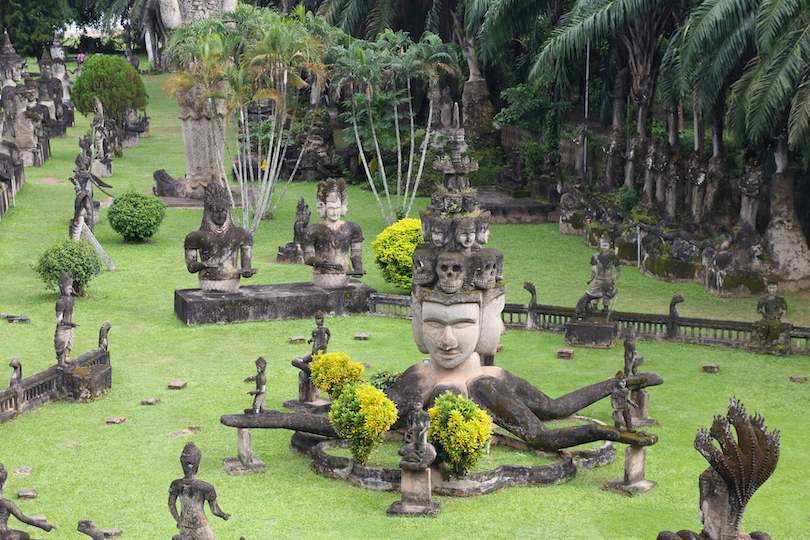
Buddha Park, with its amazing collection of Buddhist and Hindu statues, is adjacent to the Mekong River about 24 km (15 miles) from Vientiane. It contains more than 200 statues, including a 40-meter (131-foot) high statue of a sleeping Buddha.
Travelers who want the best pictures of this famous sculpture park will need to deal with the demon. Shutterbugs need to climb a stone ladder three stories to the top of a pumpkin structure; the entrance is shaped like a demon’s mouth.
The park’s best known statues include a Hindu god riding a three-headed elephant and another god with 12 faces and lots of hands.
3. Patuxai
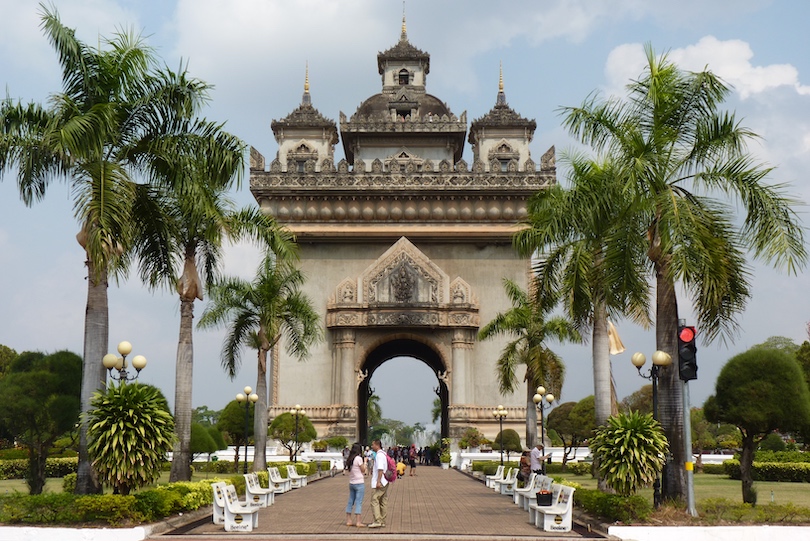
Patuxai is reminiscent of the Arc de Triomphe in Paris but with Laotian characteristics, including four arches and five ornate towers at the top. The arch or gateway, as it translates, was built to commemorate Laos gaining its independence from France.
This Vientiane attraction is dedicated to the Laotian soldiers who died in World War II and in the battles for independence from France. Patuxai is sometimes known as the “vertical runway” because it was built with American money and materials intended for a new airport. Visitors can climb up to the 7th story for a nice view of Vientiane.
2. Vientiane riverfront
When the workday is over in Vientiane, locals head to the riverfront, which teems with a smorgasbord of activities. Located on the Mekong River that separates Vientiane from Thailand, visitors will find a colorful night market, lined with stalls selling daily necessities and food to snack on while walking the promenade.
You’ll find equal amounts of serenity and bustling culture here, depending on where you choose to go. That’s a big part of what makes the city’s riverfront so delightful. A morning walk along the promenade may just become a part of your daily routine, and it’s a fun way to pick up some necessities for the day ahead. All the while, weary fishermen arrive after an even earlier morning.
The mood rises and falls through the day and reaches a crescendo in the evening. Kids play football, traveler’s relax at a bar with a Beelao and the setting sun provides the perfect backdrop to begin the evening fun.
1. Pha That Luang
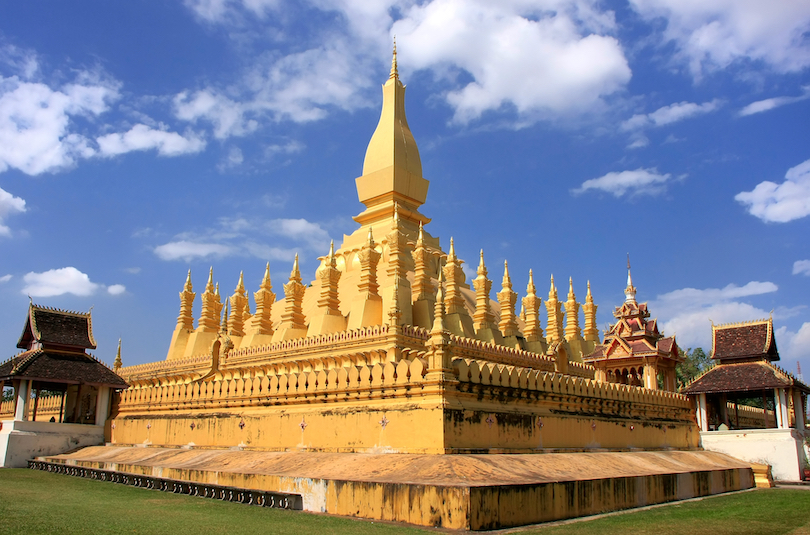
The “Great Sacred Stupa”, stands as Laos’ most venerated monument and national emblem. Pha That Luang’s significance is ubiquitous. You may recognize it from the country’s seal or the Kips in your wallet.
This impressive structure, reaching a height of 147.6 feet, consists of three levels. At its center, the main stupa, covered in gold leaf, stands above 30 smaller stupas, showcasing the kingdom’s richness and splendor. According to legend, it originated as a Hindu temple holding Lord Buddha’s breastbone in the 3rd century.
Pha That Luang was built in the 16th century on the ruins of an earlier Khmer temple. The temple was smashed by a Siamese invasion in 1828, then later reconstructed by the French in 1931.
Visit in November to experience the renowned Boun That Luang Festival centered at Pha That Luang. Witness crowds gathering to honor the stupa, alongside lively festivities such as parades, live music, and religious ceremonies.
Best Time to Visit Vientiane
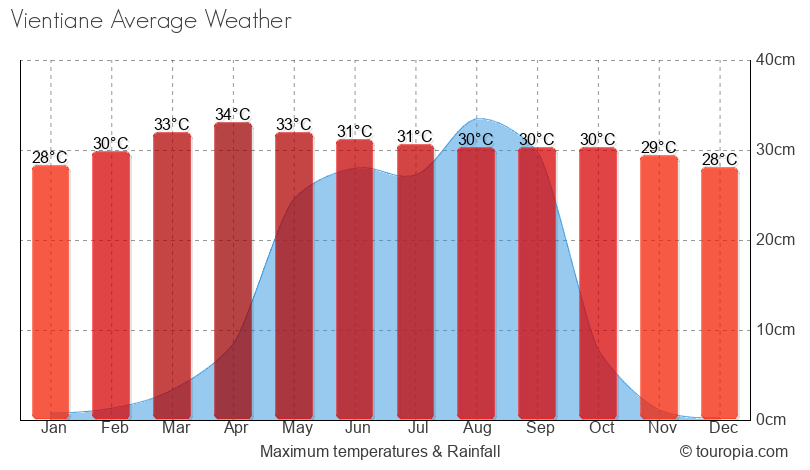
As November to February is the dry season in Laos, this is when by far the most visitors hit up Vientiane. The city is still very hot during this period though with temperatures averaging between 29 and 32°C (84 to 89°F). The evenings and nights are pleasantly cool however and there is thankfully less humidity.
As this is the high season, the capital is more expensive and crowded during these months. There are some fantastic events going on though like the Luang Festival and Vientiane Trade Fair; both in November. The weather also makes it the best time to sightsee and take scenic cruises along the Mekong River.
After this, March, April and May are excruciatingly hot with the latter also marking the start of the rainy season. April does see Pi Mai or the Lao New Year take place though and lots of fun festivities take over the capital.
June through October is then very wet and humid which makes exploring the city much less pleasant. As the sudden strong showers quickly give way to clear blue skies, some still visit in both July and August, benefiting from the lower prices and crowds. October also has the exciting Boun Souang Heun boat racing festival to watch.
Where to Stay in Vientiane
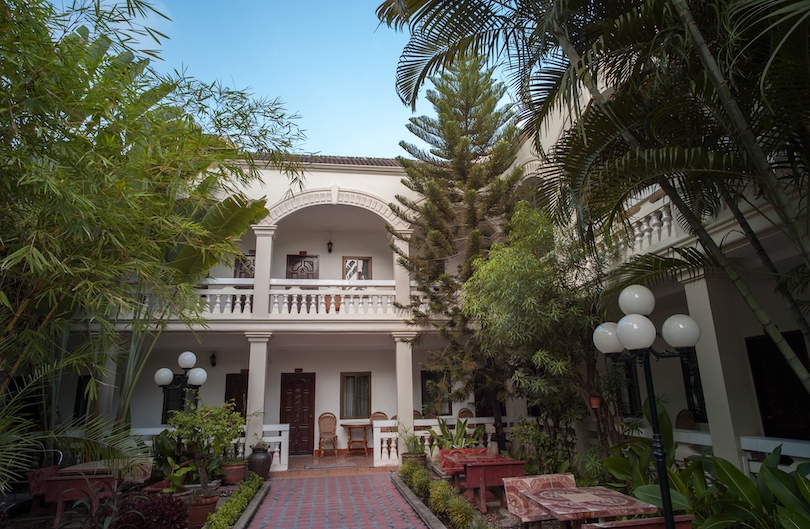
Located on the eastern bank of the Mekong River, a mere 15-minute drive from the airport, Ban Haysoke invites travelers with its breathtaking natural scenery and practical access to the city center.
The Lao Poet Hotel awaits, featuring air-conditioned rooms, complimentary Wi-Fi, and an inviting outdoor infinity pool. Embrace the allure of luxury paired with ease as you explore iconic landmarks like Wat Sisaket and the Lao National Museum, both conveniently within walking distance, ensuring a stay brimming with comfort and cultural immersion.
Just a stone’s throw from Ban Oupmung lies an ideal retreat, offering a serene escape within a culturally rich and tranquil neighborhood, yet conveniently close to the city’s prominent landmarks.
At Chandara Boutique Hotel, guests can revel in the comfort of air-conditioned rooms, take a refreshing dip in the outdoor pool, and enjoy the warm reception from staff eager to assist in arranging activities and transportation.
How to get there
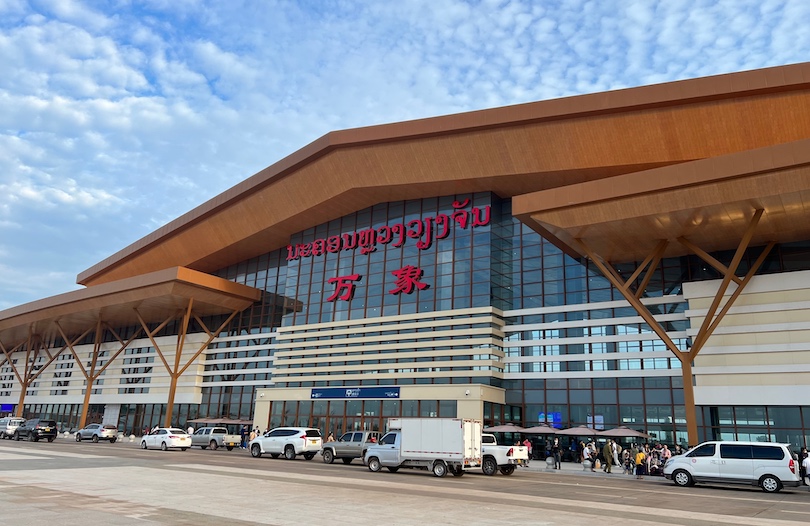
Direct flights conveniently link major Southeast Asia cities such as Singapore, Phnom Penh, and Ho Chi Minh City to Vientiane’s Wattay International Airport, serving as the primary gateway to begin your Laotian adventure.
Travelers not arriving by direct flights can opt for alternative transportation from nearby hubs like Hanoi or Bangkok, utilizing buses or trains as available. Upon landing at Wattay International Airport, a diverse range of ground transportation services ensures seamless access to Vientiane or your next destination in Laos.

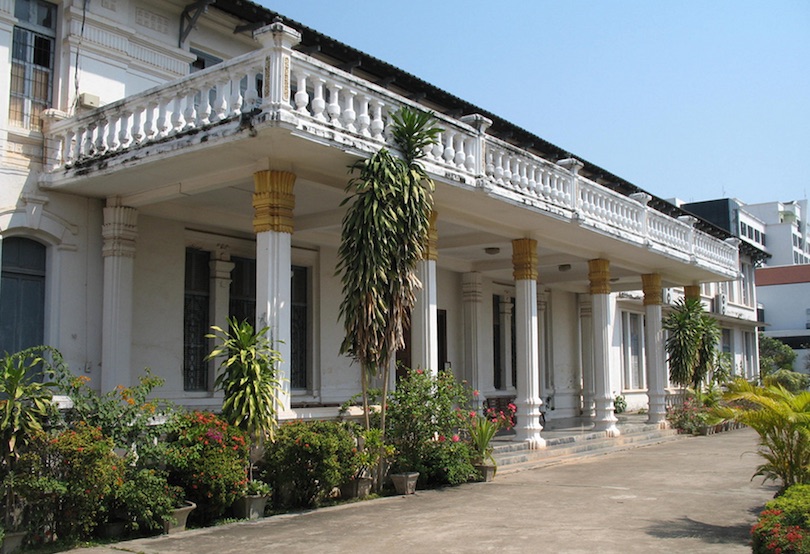
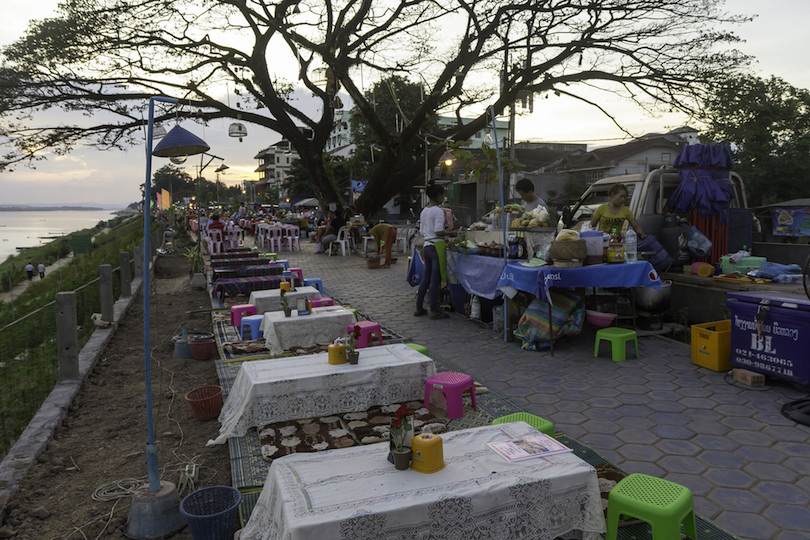
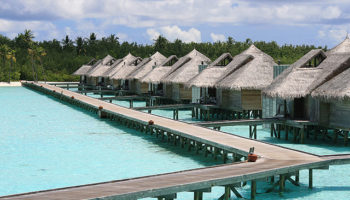

Leave a Reply